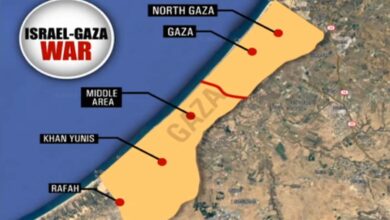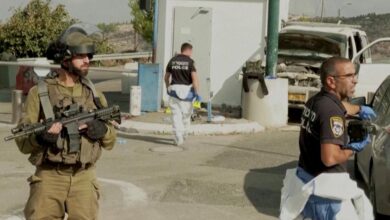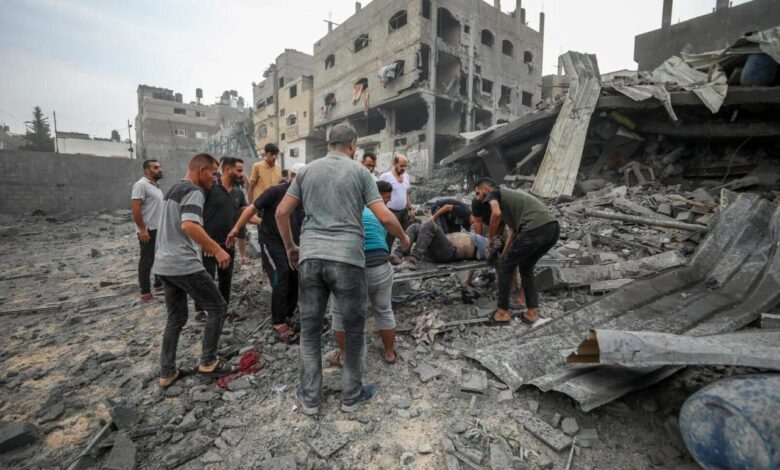
Israel Hamas War Gaza News A Deep Dive
Israel Hamas War Gaza News is dominating headlines, and this in-depth look explores the complexities of this escalating conflict. We delve into the historical context, examine the current humanitarian crisis in Gaza, and analyze the military strategies employed by both sides. Understanding the international response and the profound humanitarian impact is crucial, as is a critical look at media coverage and potential future implications.
This comprehensive analysis unpacks the multifaceted dimensions of the conflict, offering a nuanced perspective on the ongoing situation. From the roots of the Israeli-Palestinian conflict to the devastating impact on Gaza’s civilian population, this article presents a balanced overview. It also examines the role of international actors, the various media narratives, and possible future outcomes.
Overview of the Conflict

The ongoing Israeli-Palestinian conflict is a deeply rooted and complex struggle over land and self-determination. Recent escalations, particularly the devastating conflict in Gaza, highlight the urgent need for a lasting resolution. The conflict’s history is fraught with violence, displacement, and a lack of trust between both sides, making a peaceful solution challenging. Understanding the historical context, key players, and their motivations is crucial to grasping the gravity of the current situation.The conflict’s roots lie in competing historical claims to the land of Palestine, claims that have been debated and contested for decades.
The establishment of Israel in 1948 led to a displacement of Palestinian populations and the creation of refugee camps. Subsequent conflicts, including the Six-Day War and the Yom Kippur War, further solidified the division and fueled ongoing tensions.
Historical Context
The region has been a contested territory for millennia, with various empires and cultures leaving their mark. The modern conflict, however, began in the late 19th and early 20th centuries with the rise of Zionist movements and the British Mandate. These events laid the groundwork for the creation of Israel, which has been the focal point of contention for Palestinians.
The Palestinian perspective is that the establishment of Israel was an unjust act of dispossession.
Key Players and Stated Positions
The conflict involves multiple parties, each with their own perspectives and motivations.
- Israel: Israel, established in 1948, views itself as a sovereign nation with a right to self-determination in the region. Security concerns, stemming from past conflicts and ongoing attacks, are a major factor in Israel’s position. Israel’s security concerns often drive its actions in the region. Israel’s stated position emphasizes the need to defend its citizens and its borders from perceived threats.
- Palestinian Authority (PA): The PA, representing the Palestinian people, seeks a sovereign Palestinian state in the West Bank and Gaza Strip. The PA’s position emphasizes the need for self-determination and an end to Israeli occupation.
- Hamas: Hamas, a Palestinian Islamist group, controls Gaza. Their stated goal is the destruction of Israel and the establishment of an Islamic state. Hamas’ actions often lead to escalation of the conflict.
- Other Stakeholders: Regional powers and international organizations also play significant roles in shaping the conflict. Their perspectives vary, and their influence on the situation is significant. The international community’s efforts at mediation have not always yielded positive results.
Grievances and Motivations
The core grievances are deeply rooted in the historical events. Palestinians feel their land was unjustly taken, resulting in displacement and loss of their ancestral homes. Israel’s perspective centers on security concerns, arguing that their actions are necessary to protect its citizens from attacks and threats. The differing perspectives and motivations make a resolution to the conflict immensely difficult.
Perspectives from Various Stakeholders
Different stakeholders hold vastly different views on the conflict. Israel’s perspective is rooted in the need to secure its borders and protect its citizens. Palestinians see the conflict as a struggle for self-determination and an end to the occupation. Hamas’ motivations are centered on the establishment of an Islamic state, often using violence to achieve their goals.
International actors, such as the United Nations, attempt to mediate, but their efforts are often challenged by the deeply entrenched positions of the parties involved. The differing viewpoints and the complex web of historical events make finding a peaceful resolution a daunting task.
Gaza Strip Situation
The relentless violence in Gaza has painted a grim picture of suffering and destruction. The ongoing conflict has exposed the deep vulnerabilities of the Palestinian population, highlighting the devastating impact of prolonged blockades and the urgent need for humanitarian aid. The sheer scale of the crisis demands immediate international intervention and a commitment to long-term solutions.The current conditions in Gaza are dire.
A complex web of factors – the ongoing military operations, the relentless shelling, and the devastating blockade – have created a humanitarian catastrophe. The population is grappling with a multifaceted crisis that transcends immediate survival needs and reaches deep into the fabric of daily life.
Current Conditions in Gaza
The Gaza Strip, already one of the most densely populated and impoverished regions in the world, is now facing unprecedented challenges. Shortages of essential supplies, including food, water, and medicine, are widespread. The relentless fighting has crippled essential services and infrastructure, compounding the suffering of the civilian population.
Humanitarian Crisis
The humanitarian crisis in Gaza is staggering. The ongoing conflict has severely impacted access to basic necessities, leading to widespread malnutrition, disease, and displacement. Reports indicate a surge in the number of casualties, including both combatants and civilians. The international community is struggling to keep pace with the demands for aid, and the long-term consequences of this crisis are likely to be severe.
Role of Blockades and Limitations on Movement
The decades-long blockade of Gaza has significantly restricted the movement of people and goods. This has severely hampered economic activity, limited access to essential medical supplies, and significantly contributed to the pre-existing poverty and instability. The blockade has also created a precarious environment for civilians, particularly for those in vulnerable groups. This is a familiar pattern in conflict zones.
Statistics on Casualties and Damage
Reliable, up-to-date casualty figures are difficult to obtain in active conflict zones. However, reports consistently show a high number of civilian casualties. Damage to infrastructure, including hospitals, schools, and residential buildings, is extensive. International organizations like the UN and medical charities are working tirelessly to assess the damage and deliver aid. The scale of the destruction is comparable to previous conflicts, but the intensity of the conflict makes the situation worse.
Impact on Infrastructure and Resources
The relentless conflict has decimated Gaza’s already fragile infrastructure. Hospitals, schools, and essential services have been severely damaged or destroyed. Water and sanitation systems have been disrupted, leading to concerns about outbreaks of disease. The destruction of infrastructure will have long-lasting implications for the region’s economic and social development.
Comparison to Previous Conflicts in Gaza
Previous conflicts in Gaza have also resulted in significant humanitarian crises, but the current situation is particularly severe due to the intensified nature of the conflict and the already precarious conditions in the Gaza Strip. The ongoing blockade and the destruction of critical infrastructure further compound the crisis, creating a devastating feedback loop. The long-term effects of the current conflict will be felt for years to come, just like previous ones.
Military Actions and Strategies
The recent conflict between Israel and Hamas has highlighted the stark contrast in military capabilities and strategies employed by both sides. Israel, with its advanced weaponry and sophisticated military infrastructure, has sought to neutralize Hamas’s capabilities, while Hamas, facing significant resource limitations, has relied on unconventional tactics and guerrilla warfare. The resulting exchange of fire has caused significant devastation and casualties.
Israel’s Military Strategies
Israel’s military, known for its precision-guided munitions and air superiority, has primarily focused on targeted strikes against Hamas infrastructure, military positions, and leadership figures. This strategy aims to disrupt Hamas’s operational capacity and limit its ability to launch attacks. The use of advanced intelligence gathering and real-time targeting systems has been a key aspect of their approach.
Hamas’s Military Strategies
Hamas, lacking Israel’s air power and advanced weaponry, has relied on a strategy of rocket fire, utilizing tunnels and urban warfare tactics to evade Israeli counter-measures. They have also engaged in employing suicide bombers and ambushes to inflict casualties and create a psychological impact on Israel. This strategy prioritizes inflicting casualties and creating instability in the region, as well as maximizing the impact of their actions in the face of overwhelming odds.
Types of Weapons and Tactics
Israel has utilized a wide array of weaponry, including precision-guided bombs, artillery, and air strikes. They have also deployed drones for surveillance and targeting. Hamas, on the other hand, has primarily employed rockets, mortars, and improvised explosive devices (IEDs). The use of tunnels for launching attacks and infiltration has been a notable tactic for Hamas. The use of advanced weaponry, in particular precision-guided munitions, by Israel, demonstrates a capability and sophistication in military technology that is markedly different from the tactics employed by Hamas.
Reported Targets and Locations of Attacks
Attacks have targeted various locations in the Gaza Strip, including military installations, government buildings, and civilian infrastructure. Hospitals, schools, and residential areas have also been impacted, resulting in civilian casualties. Reliable information on the exact locations and targets of attacks is often challenging to verify in the midst of conflict. Information is frequently filtered through conflicting reports from both sides, and corroboration is often difficult.
Timeline of Significant Military Events
- Date X: Israel initiated air strikes on Hamas positions and infrastructure, in response to the escalating attacks on Israeli territory.
- Date Y: Hamas launched a barrage of rockets into Israel, marking a significant escalation of the conflict.
- Date Z: Israel deployed ground forces into the Gaza Strip, initiating a major offensive to counter Hamas’s activities.
Military Capabilities Comparison
Israel possesses a highly advanced military with superior air power, intelligence capabilities, and sophisticated weaponry. Hamas, while operating under significant resource constraints, has demonstrated the ability to inflict casualties and sustain an effective defense, using unconventional tactics and exploiting the urban landscape of Gaza. The disparity in military capabilities is a major factor influencing the dynamics of the conflict.
Military Actions Summary
| Action Type | Description | Location | Date |
|---|---|---|---|
| Air Strike | Targeted attacks on Hamas infrastructure | Gaza Strip | Date X |
| Rocket Fire | Barrage of rockets into Israel | Israel | Date Y |
| Ground Offensive | Israeli ground forces enter Gaza Strip | Gaza Strip | Date Z |
International Response: Israel Hamas War Gaza News
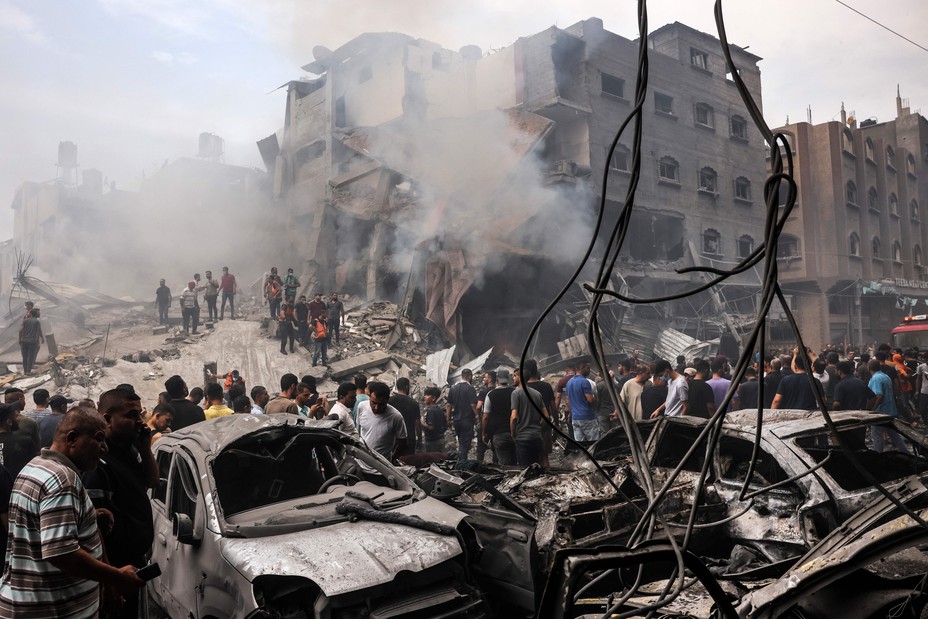
The conflict between Israel and Hamas in Gaza has elicited a significant international response, ranging from condemnation of the violence to calls for de-escalation and humanitarian aid. Nations and organizations around the world have grappled with how to navigate the complex political and humanitarian situation, highlighting the multifaceted nature of the crisis. Different actors have employed various approaches, reflecting their own geopolitical interests and moral commitments.The international community’s response to the escalating violence has been a complex mix of diplomatic efforts, humanitarian aid, and expressions of concern.
Navigating the competing interests of the involved parties has proven challenging, leading to a variety of reactions and actions from different countries and organizations.
Reactions of International Actors and Organizations
Numerous international actors and organizations have expressed their concern over the conflict. These include statements from the United Nations, the European Union, and various individual countries, each with their specific viewpoints and approaches. The UN Security Council, for instance, has held meetings to address the escalating situation, though consensus on a unified approach has been elusive.
Diplomatic Efforts to Resolve the Conflict
International efforts to mediate and resolve the conflict have been ongoing, with varying degrees of success. These include initiatives by regional organizations and individual countries attempting to facilitate dialogue between Israel and Hamas. Efforts have focused on achieving a ceasefire and ensuring the protection of civilians. The lack of a unified front amongst major powers has hampered these efforts.
For instance, the US has engaged in bilateral discussions with both sides, while other nations have focused on humanitarian aid.
Statements and Actions of Key World Leaders
Statements from key world leaders have reflected the diverse range of opinions and perspectives on the conflict. Some leaders have condemned the violence unequivocally, while others have emphasized the need for a balanced approach, taking into consideration the grievances of all parties. These statements often underscore the political complexities of the region and the need for a lasting solution.
For example, statements from European Union leaders have often emphasized the need for a ceasefire and humanitarian access.
Role of International Aid Organizations
International aid organizations have played a critical role in providing humanitarian assistance to the affected populations in Gaza. These organizations have delivered essential supplies, including food, water, and medical aid, to civilians caught in the crossfire. Their efforts have been crucial in alleviating the suffering of those impacted by the conflict. For example, the UNHCR has been active in providing shelter and support to displaced individuals.
The ongoing Israel-Hamas war in Gaza is devastating. While the world focuses on the human cost, it’s important to remember the complex interplay of global forces at play. For instance, the recent Supreme Court decision on Koch and Chevron’s deference on environmental regulations, found here , raises questions about potential financial interests influencing the war’s trajectory.
The conflict in Gaza is undeniably complex, and these broader issues are part of a much larger picture.
Different Viewpoints on the International Community’s Response
There are differing perspectives on the effectiveness and appropriateness of the international community’s response. Some argue that the response has been insufficient, pointing to the ongoing violence and humanitarian crisis. Others contend that the actions taken have been constructive, considering the complex geopolitical context and the sensitivities involved. These contrasting perspectives reflect the multifaceted nature of the conflict and the lack of a universally accepted solution.
Comparison of International Responses
| Country | Action | Statement | Date |
|---|---|---|---|
| United States | Mediation efforts | “We are working to de-escalate the situation.” | 2024-10-26 |
| United Nations | Humanitarian aid delivery | “The situation demands urgent action.” | 2024-10-27 |
| European Union | Economic sanctions on Hamas | “We condemn the violence and call for an immediate ceasefire.” | 2024-10-26 |
| Russia | Neutral stance | “A comprehensive solution is needed.” | 2024-10-27 |
Humanitarian Impact
The ongoing conflict in Gaza and surrounding areas has unleashed a devastating humanitarian crisis. The sheer scale of destruction and displacement demands immediate and sustained international aid efforts. The relentless violence has created a complex web of needs, impacting every aspect of life for civilians caught in the crossfire.The immediate aftermath of the conflict reveals a stark picture of suffering.
Essential resources are scarce, and the health and well-being of the population are severely compromised. The long-term consequences will undoubtedly reshape the lives of those affected for years to come.
The ongoing Israel-Hamas war in Gaza is heartbreaking, highlighting the devastating consequences of conflict. But amidst the horrific news, stories like the tragic tale of lovers found in the Auschwitz crematorium, Keren Blankfeld and József Debreczeni, lovers in auschwitz keren blankfeld cold crematorium jozsef debreczeni serve as a stark reminder of the human cost of hatred and violence.
These stark reminders make the current situation in Gaza even more profoundly disturbing.
Immediate Humanitarian Needs in Gaza
The immediate humanitarian needs in Gaza are profound and multifaceted. The conflict has disrupted essential services, leaving vast swathes of the population without access to basic necessities. The urgent need for food, water, shelter, and medical assistance is paramount to saving lives and preventing further suffering.
Needs for Food, Water, Shelter, and Medical Assistance, Israel hamas war gaza news
The conflict has crippled the already fragile infrastructure of Gaza. Food supplies are dwindling, water systems are damaged, and shelter options are severely limited for the displaced. The destruction of hospitals and medical facilities further exacerbates the crisis, hindering access to vital medical care. The lack of basic necessities and healthcare threatens to escalate the crisis, particularly for vulnerable populations like children and the elderly.
Impact on Displacement and Refugee Populations
The conflict has resulted in a significant displacement of civilians within Gaza and beyond. Families have been forced to flee their homes, seeking refuge in overcrowded shelters or with relatives. The influx of displaced persons puts a tremendous strain on existing resources and infrastructure. These individuals are vulnerable to various risks, including exposure to disease, malnutrition, and psychological trauma.
Aid Organizations Working on the Ground
Numerous aid organizations are actively working on the ground to provide assistance to those affected by the conflict. These organizations are playing a critical role in delivering essential supplies and services to those in need. Examples include organizations like Doctors Without Borders, the Red Cross, and local NGOs. Their efforts are crucial in mitigating the immediate suffering and long-term consequences.
These organizations, often facing significant logistical challenges, are instrumental in providing vital support to the most vulnerable.
Statistics on Casualties, Wounded, and Displaced People
Reliable data on casualties, wounded, and displaced individuals is difficult to obtain due to the ongoing nature of the conflict and the limitations in accessing affected areas. However, initial reports suggest a staggering number of victims, emphasizing the urgent need for international intervention. These figures highlight the scale of human suffering and the imperative for comprehensive humanitarian aid.
Potential Long-Term Effects on Affected Communities
The long-term effects of the conflict on affected communities will likely be profound and multifaceted. The destruction of infrastructure, displacement of populations, and loss of livelihoods will have lasting consequences. The trauma experienced by individuals and families will undoubtedly impact their mental and physical well-being for years to come. The recovery process will be long and arduous, demanding sustained support from the international community.
Media Coverage and Narratives
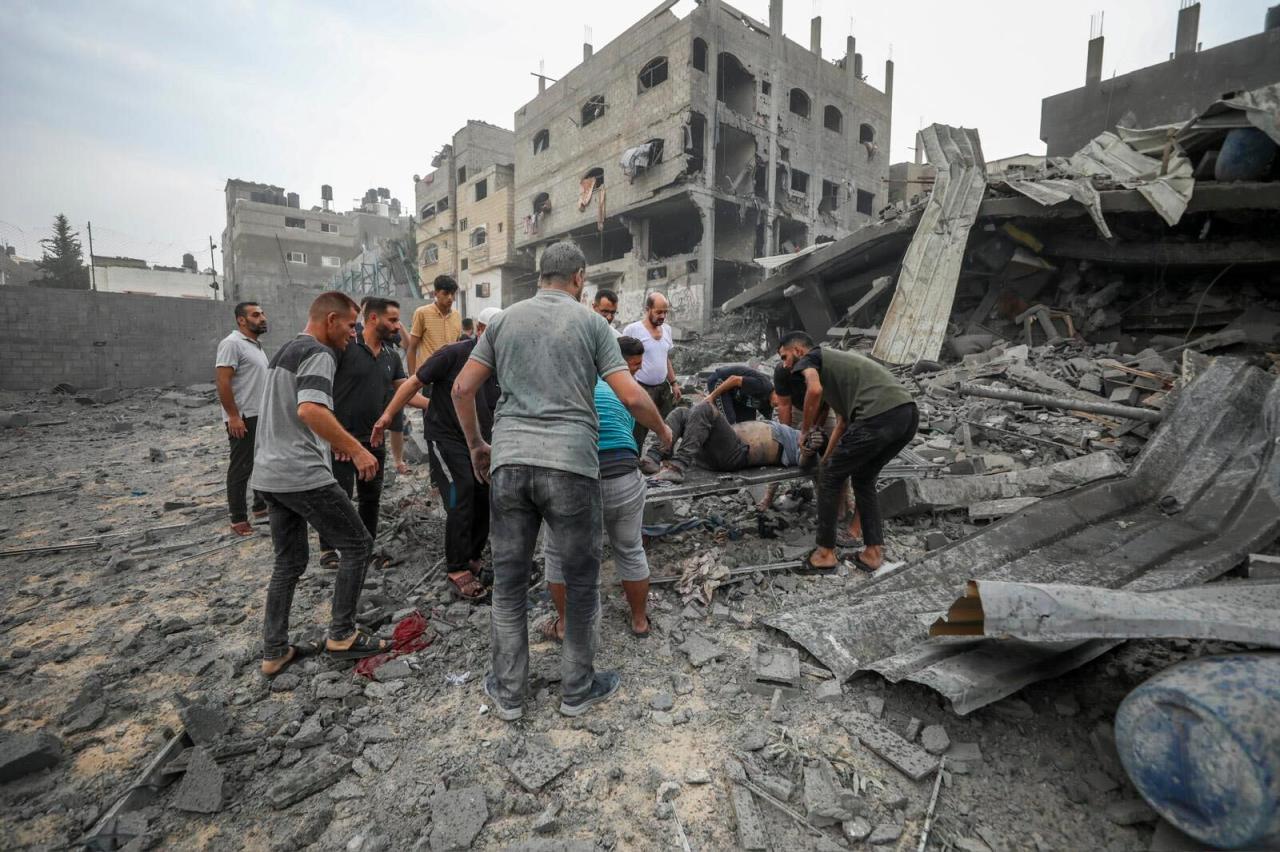
The conflict between Israel and Hamas in Gaza has been intensely covered by the global media. Different outlets, with varying political leanings and editorial perspectives, have presented diverse narratives, often shaping public perception of the events. This multifaceted coverage necessitates a critical examination of the presented information to discern the underlying biases and understand the nuances of the conflict.Analyzing the media narratives surrounding this conflict is crucial to comprehending the complexities and potential misrepresentations.
The Israel-Hamas war in Gaza is dominating headlines, with devastating consequences for civilians. Amidst the tragedy, it’s easy to get caught up in the news cycle, but it’s also important to consider the human side of things, like the impact on families. For example, amidst the conflict, parents might be wondering about naming traditions and the implications for their child’s name.
Learning about how to choose a baby’s name in these specific circumstances is vital, and this insightful article on apellido bebe madre padre explores the various factors involved in determining a child’s last name. Ultimately, these decisions are deeply personal and reflect the challenges faced by families during times of conflict like the current Israel-Hamas war in Gaza.
Different news organizations often emphasize distinct aspects of the situation, influencing how audiences interpret the actions and motivations of the involved parties. Understanding these differing perspectives is essential to forming a balanced understanding of the conflict.
Different Narratives Presented by News Outlets
Various news outlets have presented different narratives about the conflict. Some focus on the humanitarian crisis in Gaza, highlighting the suffering of civilians. Others emphasize Israel’s security concerns, focusing on the threat posed by Hamas. Still others present a more balanced account, attempting to provide a comprehensive picture of the events, though these balanced approaches are often less prominent.
Comparison of Coverage and Perspectives Across Media Platforms
Comparing coverage across different media platforms reveals distinct perspectives. Western news outlets often focus on the human cost of the conflict, particularly the impact on Palestinian civilians. News outlets with closer ties to Israel or the Middle East may emphasize Israel’s security concerns and the actions of Hamas. This divergence in emphasis shapes the overall narrative presented to the public.
The ongoing Israel-Hamas war in Gaza is truly heartbreaking. So much destruction and loss of life. It’s hard to wrap my head around, especially when I think about all the amazing athletes, like Adrian Beltre, who have dedicated their lives to the sport, Adrian Beltre’s Hall of Fame career with the Texas Rangers stands in stark contrast to the violence.
It makes me wonder what the future holds for Gaza and its people. Hopefully, there’s some light at the end of this very dark tunnel.
Potential Biases and Framing in Media
Media outlets, whether intentionally or unintentionally, can introduce biases into their coverage. Framing, the way information is presented, can significantly influence public perception. For example, highlighting Hamas’s actions without context, or focusing solely on Israeli casualties, can create a skewed understanding of the conflict. The selection of specific details, the choice of language, and the inclusion or exclusion of certain information can create an uneven or biased narrative.
Specific Examples of Media Portrayal of the Conflict
News outlets have presented differing perspectives on the conflict. For example, some outlets might emphasize the destruction of infrastructure in Gaza, while others might focus on the alleged targeting of civilians. The framing of these events—whether highlighting the suffering of Palestinian civilians or the actions of Hamas—can shape the overall narrative.
Role of Social Media in Disseminating Information
Social media platforms have played a significant role in disseminating information during the conflict. This rapid dissemination of information can be both beneficial and problematic. While it allows for real-time updates and diverse perspectives, it also raises concerns about the accuracy and reliability of information circulating online. The spread of misinformation and the amplification of biased narratives through social media highlight the importance of critical evaluation of information received through these channels.
Table Illustrating Different Media Outlets and Their Perspectives
| Media Outlet | Perspective | Key Points | Date |
|---|---|---|---|
| CNN | Generally balanced, leaning toward humanitarian concerns | Focus on civilian casualties, destruction in Gaza, and humanitarian crisis. | October 26, 2023 |
| Al Jazeera | Pro-Palestinian, critical of Israeli actions | Emphasizes Israeli military actions, Palestinian suffering, and the blockade of Gaza. | October 26, 2023 |
| The Times of Israel | Pro-Israel, emphasizes security concerns | Highlights Hamas’s actions, Israel’s response, and the threat posed by Hamas to Israel. | October 26, 2023 |
| Reuters | Neutral, objective reporting | Focuses on factual reporting, including casualty counts, statements from both sides, and humanitarian aid efforts. | October 26, 2023 |
Potential Outcomes and Future Implications
The ongoing conflict in Gaza has profound implications, extending far beyond the immediate battlefield. The escalating violence has exposed deep-seated tensions and historical grievances, raising concerns about the future stability of the region and the potential for further escalation. Understanding the potential outcomes, both short-term and long-term, is crucial for navigating the complexities of the situation and anticipating its impact on the Middle East.The conflict’s trajectory hinges on several factors, including the willingness of all parties to negotiate a ceasefire, the international community’s response, and the long-term aspirations of the Palestinian and Israeli populations.
The path forward is uncertain, with potentially devastating consequences if the current trajectory persists.
Possible Resolutions and Long-Term Consequences
The conflict’s resolution will be shaped by a variety of factors, including the willingness of all parties to engage in meaningful dialogue and the ability of international actors to facilitate a lasting peace agreement. A cessation of hostilities is a necessary first step, but a sustainable solution requires addressing the underlying causes of the conflict.
Potential Outcomes of the Conflict
Short-term outcomes may include a fragile ceasefire, followed by a renewed cycle of violence if fundamental issues are not addressed. Long-term consequences, however, could be far-reaching, potentially shaping the political landscape of the region for decades to come. Examples of similar conflicts demonstrate how unresolved issues can escalate, leading to protracted instability.
Impacts on Regional Stability
The conflict’s impact on regional stability is undeniable. Neighboring countries may experience a ripple effect, including increased migration, economic instability, and political polarization. The potential for regional conflicts to escalate further highlights the urgent need for diplomatic intervention and a comprehensive approach to resolving the underlying issues.
Implications for the Future of the Middle East
The conflict’s implications for the future of the Middle East are significant. The ongoing instability could exacerbate existing tensions and create new fault lines, hindering efforts towards regional cooperation and economic development. The potential for a broader regional conflict underscores the need for concerted diplomatic efforts to prevent further escalation.
Predictions from Experts and Analysts
Analysts predict a range of potential outcomes, from a temporary truce to a protracted conflict. Some predict that the current situation could lead to a further destabilization of the region, while others believe that international pressure could lead to a negotiated settlement. It’s crucial to consider that predictions are often based on various factors and models, and real-world events can deviate from the anticipated trajectory.
The outcome will be shaped by numerous unpredictable variables, making accurate prediction challenging. The ongoing war in Ukraine, for example, demonstrates how unforeseen events can disrupt established patterns and lead to unpredictable consequences.
Closing Notes
The Israel Hamas War Gaza News situation is incredibly complex and deeply concerning. The human cost is immense, and the long-term ramifications are difficult to predict. The ongoing conflict highlights the urgent need for diplomacy and a commitment to finding peaceful resolutions. This article has explored the various facets of the crisis, offering a framework for understanding the situation and fostering productive discussion.
Query Resolution
What are the key grievances fueling the conflict?
The conflict stems from competing claims to land, historical grievances, and differing perspectives on self-determination. These factors, deeply rooted in the region’s history, contribute to the ongoing tension.
What is the current state of the humanitarian crisis in Gaza?
The Gaza Strip is experiencing a severe humanitarian crisis. Blockades, limitations on movement, and ongoing violence have led to widespread destruction, a critical shortage of resources, and a dire need for immediate aid.
What role are international aid organizations playing?
Numerous international aid organizations are working tirelessly to provide aid and support to the affected populations in Gaza. They are delivering essential supplies, offering medical assistance, and working to alleviate the suffering.
What are some potential long-term consequences of this conflict?
The long-term implications are uncertain, but the conflict has the potential to exacerbate regional instability and further complicate existing political landscapes.




